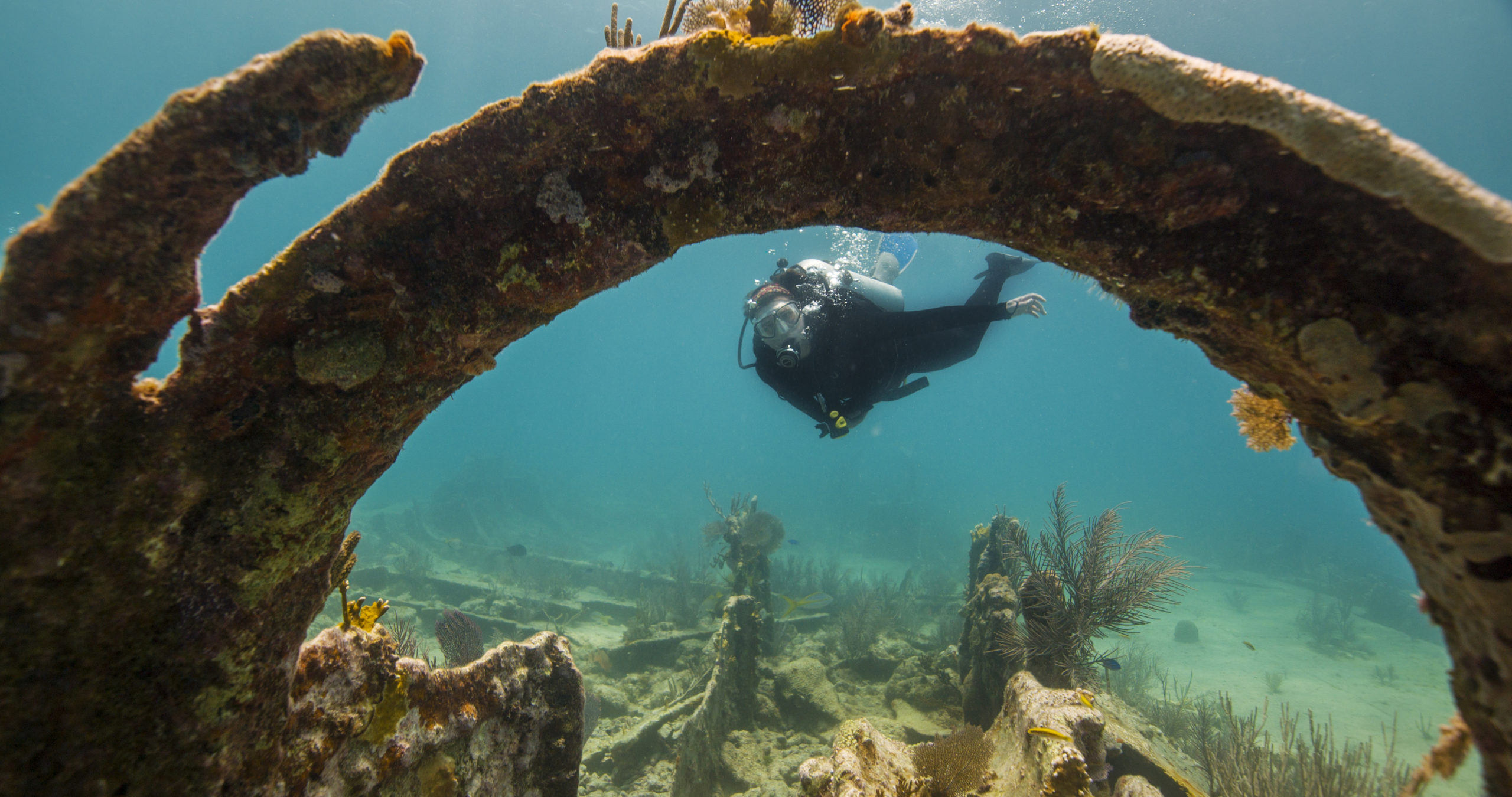
Discover our History: Diving in our National Marine Sanctuaries
America’s national marine sanctuaries are home to an incredible variety of ocean life: gentle giants, microscopic plankton, vibrant habitats, and more. However, many people are surprised to learn that these wondrous places also protect and preserve significant cultural artifacts from throughout our nation’s history. For SCUBA divers, the sites of shipwrecks, downed planes, and other cultural and historic relics make for memorable dives and an underwater trip back in time. There are hundreds of shipwrecks and sites to dive within the National Marine Sanctuary System. Here are a few of our favorites:
Channel Islands
Off the coast of Southern California are the Channel Islands and the national marine sanctuary named after them. Along the seafloor of the sanctuary are the remains of shipwrecks and prehistoric land features. For centuries, the Channel Islands have been a hub for exploration, travel, and commerce. The waters can be treacherous, characterized by strong currents, unpredictable weather, dense fog, and hidden reefs which have led many vessels to their watery demise. Individually and collectively, the wrecks contained within the sanctuary’s boundaries tell an important story of maritime culture and hold important historic relics – people from all over the world have traveled these waters for food, exploration, or even warfare. Some of the most notable wrecks within Channel Islands National Marine Sanctuary include: Grumma AF-2W Guardian, a U.S. military aircraft designed and used to seek out enemy submarine patrols, and Del Rio, a vessel used for commercial fishing and served as a minesweeper in Word War II. Beyond the historic collection of shipwrecks, the cold waters surrounding Channel Islands provide a rich biological diversity and one of the best diving spots in the world filled with beautiful kelp forests, sea caves, and more.
For a full list of wrecks in Channel Islands and a map of their locations, click here.
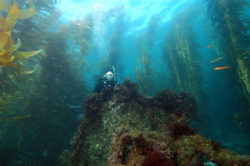
The wreck of Winfield Scott, a sidewheel steamer that sank in 1853 in what is now Channel Islands National Marine Sanctuary. Today, the vessel serves as an artificial reef, harboring invertebrate and fish communities within the kelp forest. Photo: Robert Schwemmer/NOAA
Florida Keys
Alongside America’s only living barrier reef is the famous Shipwreck Trail protected by Florida Keys National Marine Sanctuary. Spanning from Key Largo down to Key West, the Trail contains nine historic shipwrecks, scattered along the coral reefs and buried among the soft sand offshore. These shipwrecks tell the story of the Florida Keys and their waters that are notoriously tricky to navigate. This sanctuary is the only one in the National Marine Sanctuary System that allows artificial reefs – the intentional sinking of ships and other human-made structures to create a settling areas for coral reef ecosystems to develop, creating rich fishing and diving sites. One of the notable artificial reefs in the sanctuary is the Duane, which divers can explore with the assistance of the underwater guide provided by the sanctuary that includes information about each wreck’s history, buoy locations, and site information like notable species and depth.
If diving in the Keys check out the Blue Star Program, a program that recognizes dive operators that practice safe, responsible, and educational diving practices to reduce the impact of these activities on ecosystems in the Florida Keys.
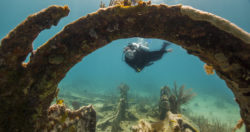
A diver explores the wreck of the City of Washington, an an iron hulled steamer which sank on July 10, 1917 and now lies in Florida Keys National Marine Sanctuary. Photo: David J. Ruck/NOAA
Monitor
Located off the coast of Cape Hatteras, North Carolina, lies the “Graveyard of the Atlantic”, a collection of military shipwrecks. The sanctuary, protecting one square mile of ocean, is home to the USS Monitor, a famed ironclad ship that led the Union Navy in America’s Civil War and sank during the Battle of Hampton Road. Beyond the USS Monitor, the “Graveyard of the Atlantic” is home to thousands of additional historic shipwrecks and significant maritime heritage resources from World War I and World War II. In addition to being great dive sites, these ships underscore the importance of our maritime heritage and represent why these underwater treasures should be protected. This sanctuary is a challenging dive, however, limited to advanced technical divers due to the strong current and the depth of the wrecks. Those who can dive this site get to see part of our nation’s history up close and personal!
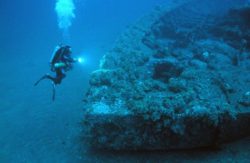
The USS Monitor, a famed Civil War ironclad that sank during a storm on December 31, 1862, and wasn’t found again until 1973. Its discovery prompted the creation of the first national marine sanctuary, Monitor National Marine Sanctuary. Photo: NOAA Monitor Collection
Stellwagen Bank
Known for whales and fishing, Stellwagen Bank National Marine Sanctuary off the coast of Massachusetts is also home to numerous shipwrecks at the mouth of the Massachusetts Bay. The sanctuary is a historic shipping area and was first mapped to tell navigators they were approaching dangerous waters. It’s no surprise there are so many sunken ships here!
Stellwagen Bank is best to dive during the warmer months of the year and usually offers great visibility, though it is a challenging dive due to strong currents and colder temperatures, even in the summer. Advanced divers looking for a history lesson and a rewarding dive should plan to explore the sanctuary during slack tides, as this is when conditions are best. Some notable wrecks to explore include the Lamartine, Paul Palmer, and two coal schooners that collided, the Frank A. Palmer and Louise B. Crary.
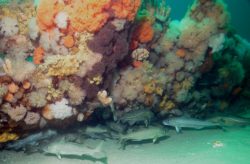
Atlantic cod swim under a section of schooner Paul Palmer’s hull. Photo: Matthew Lawrence/NOAA
Thunder Bay
Located in Lake Huron, Thunder Bay National Marine Sanctuary earned itself the nickname of Shipwreck Alley. Over the years, the sanctuary’s murky waters, jagged rocks, and foggy weather have claimed many ships. In fact, the sanctuary protects more than 100 known shipwrecks in their final resting places. The site is open to snorkelers, recreational divers, and technical divers. Many of the popular dive sites are marked by buoys, so they are easy to find.
The sanctuary is great for wreck diving because Lake Huron’s cold, fresh waters preserve the ships’ materials quite well. These wrecks, frozen in time, tell the stories of our nation’s industrial development, technological innovation, and maritime history. Some famous wrecks to explore include the Grecian, one of the last “fast steel flyers”, a series of sister ships that used steam and sail power, a rarity in the late-1800s, and the J.J. Audubon and Defiance, schooners built during a period of high demand for speedy vessels that could travel the Great Lakes faster than previous models.

The wreck of the New Orleans, a wooden side wheel steamboat that was steaming north on Lake Huron when it ran into a heavy fog on June 13, 1849. While its passengers were all rescued, strong winds and waves destroyed the vessel a few days later. Now the New Orleans rests 15 feet down in Thunder Bay National Marine Sanctuary. Photo: David Ruck/NOAA
America’s national marine sanctuaries provide a perfect opportunity to discover a piece of our past. To learn more about dive sites and opportunities within the National Marine Sanctuary System, click here. For those of you who want to experience sanctuaries but can’t make it out onto the water yet, the Office of National Marine Sanctuaries provides immersive 360-degree virtual dives, available on desktop or mobile and accessible all year long. Happy exploring!
